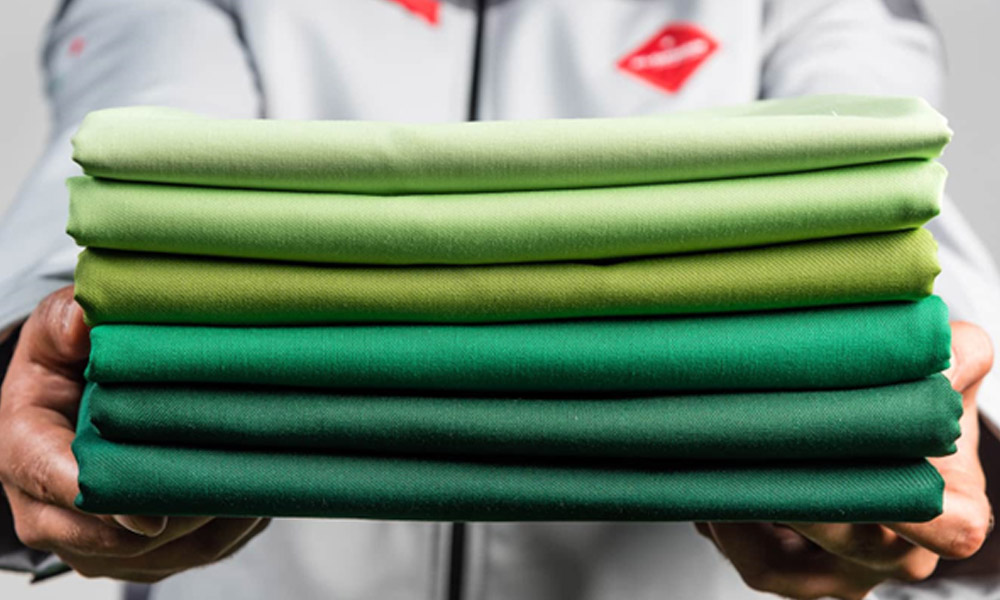Fashion
How Designers Are Embracing Sustainable Fabrics in 2025
Published
2 hours agoon
By
Admin
The fashion industry is undergoing a remarkable transformation. As environmental concerns grow and consumer values shift, designers around the world are rethinking how they create clothing — from the materials they use to the processes they follow. In 2025, sustainable fabrics have become the heart of this revolution, redefining what it means to be stylish, ethical, and responsible.
This article explores how designers are embracing sustainable fabrics in 2025, the technologies driving these changes, and what the future holds for eco-friendly fashion.
Introduction
Sustainability is no longer just a trend; it’s a design philosophy shaping the future of fashion. Designers across the globe — from independent artisans to luxury fashion houses — are now prioritizing sustainable fabrics to reduce waste, conserve resources, and support ethical production.
In 2025, sustainability has moved beyond marketing slogans. It’s now an industry standard that influences how garments are designed, produced, and worn. The shift is driven by eco-conscious consumers who demand transparency, quality, and responsibility from the brands they support.
What Are Sustainable Fabrics?
Sustainable fabrics are materials produced in ways that minimize environmental impact and promote social responsibility. They come from renewable resources, use less water and energy, and often biodegrade naturally at the end of their lifecycle.
Unlike conventional textiles made with harmful dyes and synthetic fibers, sustainable fabrics focus on reducing pollution, waste, and carbon emissions.
Common examples include:
- Organic Cotton: Grown without pesticides or harmful chemicals.
- Bamboo: Naturally regenerative and requires little water.
- Tencel (Lyocell): Made from sustainably harvested wood pulp.
- Recycled Polyester: Created from repurposed plastic bottles and textile waste.
- Hemp: Durable, versatile, and one of the most eco-friendly crops.
These materials represent a movement toward responsible design — one where fabric production respects both people and the planet.
The Global Shift Toward Sustainable Fashion
By 2025, the global fashion industry has experienced a paradigm shift toward sustainability. A decade ago, fast fashion dominated the market, producing low-cost garments at the expense of the environment. Today, consumers are more informed and demand better practices.
According to recent industry reports, over 70% of fashion brands have committed to using sustainable fabrics in at least part of their collections. Social media, documentaries, and activist movements have played a massive role in raising awareness about fashion’s environmental footprint.
The rise of the slow fashion movement has encouraged consumers to buy less, choose better, and value quality over quantity. Governments have also introduced stricter environmental regulations, urging manufacturers to adopt eco-friendly methods.
All of these factors have created the perfect environment for designers to experiment with sustainable fabrics and innovative production techniques.
Why Designers Are Prioritizing Sustainable Fabrics
The adoption of sustainable fabrics isn’t just a moral choice — it’s a smart business decision. Modern designers are prioritizing sustainability for several reasons:
- Ethical Responsibility
Designers recognize their role in shaping a more responsible fashion industry. Using sustainable fabrics allows them to support ethical farming, fair trade, and cleaner production processes.
- Consumer Demand
Eco-conscious consumers are willing to pay more for responsibly made clothing. Brands that align with these values build stronger trust and loyalty.
- Long-Term Cost Benefits
While sustainable fabrics may have higher upfront costs, they often offer superior durability and lower environmental taxes, making them a better investment for both producers and consumers.
- Innovation and Creativity
Designers are inspired by the challenge of working with new materials. From biodegradable fabrics to lab-grown leather, sustainability has unlocked a new era of creativity.
In short, sustainable fabrics allow designers to blend style, innovation, and ethics seamlessly.
Popular Sustainable Fabrics Designers Are Using in 2025
The year 2025 has seen an explosion in the variety and availability of sustainable textiles. Here are the most popular options dominating fashion studios and runways:
- Organic Cotton
Still the most widely used sustainable material, organic cotton avoids synthetic pesticides and reduces water consumption. It’s breathable, soft, and ideal for everyday wear.
- Tencel (Lyocell)
Made from sustainably sourced wood pulp, Tencel offers a silky feel and is fully biodegradable. It’s become a favorite for eco-luxury brands.
- Recycled Polyester
Once considered waste, plastic bottles and discarded fabrics are now being turned into new garments. Recycled polyester gives new life to materials that would otherwise pollute the planet.
- Hemp
Known for its strength and versatility, hemp fabric requires minimal water and pesticides. It’s used in everything from denim to outerwear.
- Piñatex and Orange Fiber
Innovative alternatives made from pineapple leaves and citrus peels are redefining vegan leather. These creative materials showcase how sustainability can also mean luxury.
Designers in 2025 are combining these fabrics to achieve both aesthetic appeal and environmental balance.
Technological Innovations Driving Fabric Sustainability
Technology has become a crucial ally in advancing sustainable fabrics.
- 3D Printing and Zero-Waste Cutting
3D printing allows designers to produce garments layer by layer, minimizing leftover fabric waste. Zero-waste cutting patterns also ensure every inch of material is used efficiently.
- Waterless Dyeing and Digital Printing
Traditional dyeing consumes enormous amounts of water. Waterless dyeing technology and digital printing now allow vivid color production with minimal environmental impact.
- Smart and Biodegradable Textiles
Researchers have developed fabrics made from natural polymers like algae and seaweed that biodegrade safely after disposal.
- Blockchain for Supply Chain Transparency
Designers are using blockchain to track where and how their fabrics are made. This ensures ethical sourcing and builds consumer trust.
Thanks to these innovations, sustainable fabrics are no longer a compromise — they’re a mark of advanced design thinking.
Case Studies: Designers Leading the Sustainable Revolution
- Stella McCartney
A pioneer in eco-luxury, Stella McCartney continues to lead the sustainable fashion movement by using plant-based leathers and organic materials in her 2025 collections.
- Gabriela Hearst
Known for her elegant minimalist style, Hearst incorporates recycled cashmere and deadstock fabrics to create timeless pieces with minimal waste.
- UAE Designers Embracing Sustainability
In Dubai and Abu Dhabi, emerging designers are joining the movement. Brands such as The Giving Movement and All Things Mochi are setting examples by producing garments with recycled fabrics and ethical labor practices.
- Luxury Fashion Houses
Even global giants like Gucci and Burberry have launched “green collections,” committing to sustainable sourcing and carbon neutrality goals.
These examples show that sustainability is not a niche concept — it’s the new normal for fashion in 2025.
Challenges Designers Face in Adopting Sustainable Fabrics
Despite growing adoption, designers still face several challenges in fully integrating sustainable fabrics:
- Higher Production Costs: Eco-friendly fabrics often cost more to produce, impacting pricing and accessibility.
- Limited Availability: Not all regions have easy access to sustainable material suppliers.
- Balancing Creativity and Practicality: Some sustainable fabrics have limitations in texture, color, or performance.
- Consumer Misconceptions: Many consumers still equate sustainable fashion with plain or less stylish designs.
Overcoming these obstacles requires collaboration between fabric producers, designers, and governments to make sustainable fashion scalable and affordable.
How Sustainability Is Influencing Fashion Education and Trends
Fashion schools around the world have begun updating their curricula to include sustainability at every level. Students are now learning about life cycle assessment, eco-friendly textile design, and circular fashion systems.
Sustainable Trends in 2025 Include:
- Circular Fashion: Clothing designed for longevity, repair, and recycling.
- Upcycling: Repurposing old garments into new designs.
- Minimalism: Quality over quantity — a focus on timeless, versatile pieces.
- Natural Dyes: Using plant-based pigments for safe, vibrant colors.
These changes ensure that the next generation of designers grows up viewing sustainability not as an option, but as the foundation of good design.
The Future of Sustainable Fabrics Beyond 2025
Looking ahead, innovation will continue to shape the next wave of sustainable fabrics. Scientists are experimenting with lab-grown materials like spider silk and mycelium (mushroom-based leather). AI is being used to predict fabric performance and reduce production waste.
Additionally, algae-based fabrics, carbon-capturing textiles, and fully compostable clothing are already being tested by forward-thinking brands.
The future of sustainable fabrics is not only about reducing harm — it’s about creating regenerative systems where fashion contributes positively to the planet.
Conclusion
In 2025, the fashion industry stands at the intersection of creativity and conscience. Designers have proven that sustainability and style can coexist beautifully. From organic cotton to innovative fruit-based leathers, sustainable fabrics are driving a new design era — one that values ethics, innovation, and responsibility in equal measure.
As consumers, supporting brands that use sustainable fabrics is more than a fashion choice — it’s a statement of purpose. The journey toward a greener, more sustainable fashion future has only just begun, and designers are leading the way one stitch at a time.

Who Is Pat McConaughey? The Private Brother of Matthew McConaughey

The Best Baby Blankets for All Seasons: A Parent’s Guide

Why Design Storytelling Is the New Luxury

Best Gold Trading Indicators for Beginners

How Designers Are Embracing Sustainable Fabrics in 2025

Off-Grid Safety: How TruckClaws Empower Solo Travelers

4000taxi.com: A Small Website That Might Fix the Big Problems of UK Taxi Travel

Creating Engaging Social Media Campaigns That Convert

Vegas Matt Net Worth 2025: Story of a High-Stakes Gambler and Social Media Star

Enhancing Your Marketing Strategies Through Global Address Validation and Direct Mail Marketing

Curious About JOI Database? Read This First Before You Click Anything

Should You Use Wooflix in 2025? Honest Review and Best Alternatives

Jacqueline Bernice Mitchell: The Inspiring Story of Jerry Rice’s Ex-Wife

Where Is Noelle Watters Now? Jesse Watters’ Ex-Wife’s Life After Divorce

ECMISS: The Intelligent System Behind Smarter Everything

Who Is Marlene Knaus? The Untold Story of Niki Lauda’s First Wife

Is F2Movies Safe to Use? The Truth Nobody Tells You

Who Is Raquel Pedraza? Meet Taylor Fritz’s Tennis Star Ex-Wife

Alisande Ullman Today: What Happened After Her Divorce from Leslie Nielsen?

Where Is Anne Steves Now? The Truth About Rick Steves’ Ex-Wife

Who Is Pat McConaughey? The Private Brother of Matthew McConaughey

The Best Baby Blankets for All Seasons: A Parent’s Guide

Why Design Storytelling Is the New Luxury

Best Gold Trading Indicators for Beginners

How Designers Are Embracing Sustainable Fabrics in 2025

Off-Grid Safety: How TruckClaws Empower Solo Travelers

4000taxi.com: A Small Website That Might Fix the Big Problems of UK Taxi Travel

Creating Engaging Social Media Campaigns That Convert

Vegas Matt Net Worth 2025: Story of a High-Stakes Gambler and Social Media Star

Enhancing Your Marketing Strategies Through Global Address Validation and Direct Mail Marketing
Categories
Trending
-

 Entertainment3 months ago
Entertainment3 months agoCurious About JOI Database? Read This First Before You Click Anything
-

 Entertainment3 months ago
Entertainment3 months agoShould You Use Wooflix in 2025? Honest Review and Best Alternatives
-

 Celebrity2 months ago
Celebrity2 months agoJacqueline Bernice Mitchell: The Inspiring Story of Jerry Rice’s Ex-Wife
-

 Celebrity2 months ago
Celebrity2 months agoWhere Is Noelle Watters Now? Jesse Watters’ Ex-Wife’s Life After Divorce
